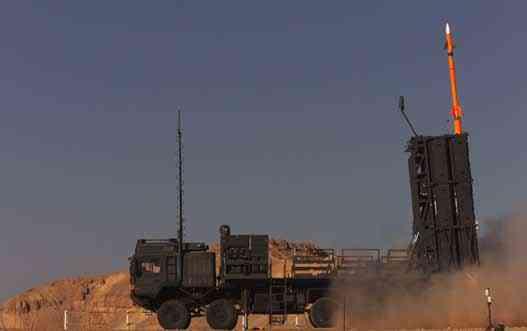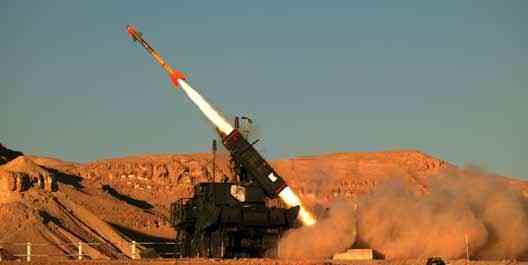
7 minute read
Czech Republic Chooses Rafael’s SPYDER air Defense System
major explosions of fuel oil tanks, the deck and hull on port and starboard side got ruptured. This led to escape of oil water emulsion from engine room to sea and formation of minor oil sheen. On 9th , ICG Dornier aircraft which was preemptively positioned at Sri Lankan air base (Mattala) was launched in Pollution Response configuration for spray of Oil Spill Dispersant (OSD) to neutralise the sheen. Simultaneously, ICG ships in area also sprayed OSD and churned the waters for kinetic action and to accelerate the disintegration of the oil sheen. Under no circumstances, the major cargo tanks were breached, nor the Kuwait export crude escaped to sea.
A major milestone was achieved by preventing the oil spill during the entire operation. Had there been an oil spill of such magnitude, the fisheries and livelihood of fishermen of the entire Region would have been severely impacted. The collective surface firefighting efforts was supplemented by aerial dropping of Dry Chemical Powder (DCP), a firefighting substance, by Sri Lankan Airforce. Further, Sri Lankan Naval authorities sought ICG support for Five Tons DCP for firefighting which was sourced from M/s IOC, Chennai and airlifted to Trincomalee. The salvage team hired by the owner which arrived on 6th September aligned with ICG plan and approach for the firefighting operation. The salvage team boarded the vessel on 9th and assessed no hotspots, flames/smoke with no breach of cargo tanks. Naval Architect in salvage team confirmed that the ship’s stability remained within the safe zone. Indian Coast Guard continued to closely monitor the situation even after the salvage team took over control of the ship.
Advertisement
Post declaration by the salvour that the casualty vessel is safe as also upon receipt of information from the Sri Lankan authorities through HCI in Sri Lanka, the ICG units were withdrawn from the scene on 10th .The large scale, professional and proactive efforts of ICG have been appreciated at International level by the Government and Armed Forces of Sri Lanka as also by former President of Maldives. A major ecological disaster was averted in India’s backyard by joint efforts of Indian Coast Guard, Sri Lankan Armed Forces and tugs deployed by Sri Lankan Naval authorities and DG (Shipping). The incident response also highlighted close co-operation and inter-operability with forces of our immediate neighbours in all together a new dimension, invoking the established MoU between the two Nations. This operation has brought to fore the lead role played by India and the capability of ICG to respond to an emerging situation to protect the maritime environment in living up to its motto of “Vayam Rakshamah” – “We Protect”.

The Czech Ministry of Defense has Informed the Israel Ministry of Defense of its Decision to Equip its Military with an Israeli Air Defense System Produced by Rafael Advanced Defense Systems.
Defense Minister, Benny Gantz said that: “We thank the Czech government for their partnership and for the decision to equip their military with Israeli air defense systems. This is another significant step in strengthening security relations between our two countries, and it is also great news for Israeli defense industries during such a complex period.”
Following an international tender process, which lasted several years, the Czech Ministry of Defense informed the Directorate of International Defense Cooperation (SIBAT) in the Israel Ministry of Defense, of its decision to equip its military with Israeli air defense systems.
The Czech government approved the launch of procurement negotiations for four Israeli “SPYDER” batteries, within the framework of a GTG agreement between the two countries. Israel was selected as the sole supplier for the project and the expected agreement between the countries’ defense ministries is estimated at hundreds of millions of dollars.
SPYDER (Surface-toAir Python & Derby), is a quick reaction, low- tohigh surface-to-air missile system designed to counter attacks by a variety of aerial threats including aircraft, helicopters and UAVs. The system provides effective protection of valuable assets, as well as first-class defense for maneuvering forces located in combat areas. The SPYDER system includes a radar system produced by Elta, a subsidiary of Israel Aerospace Industries (IAI).
Ariel Karo, EVP marketing and business development at Rafael: “We are very proud to have been selected to provide SPYDER systems to the Czech Republic through a GTG process. The decision to select SPYDER, developed and produced by Rafael, is a significant vote of confidence in our proven air defense capabilities demonstrated over the years through a variety of solutions that span from Iron Dome, David’s Sling, and the SPYDER air defense system, in service and combat-proven in different countries around the world.”
Rafael designs, develops, manufactures and supplies a wide range of high-tech defense systems for air, land, sea and space applications. Rafael’s systems are based on vast expertise, technological know-how, and a thorough understanding of the specific operational requirements of its customers. The company’s diversified array of innovative solutions at the leading edge of global technology include Land, Air Superiority, Naval and Underwater, Space and Cyber solutions.


No plan for new Ordnance Manufacturing Industries & Laboratories
Defence ministry has announced that there are no plans for establishing new ordnance industries and laboratories in the government sector.
Defence Public Sector Undertakings, Ordnance Factory Board and the private industries have supplied various Defence Equipment such as missiles, torpedoes, Offshore Patrol Vessels, radars, electronic warfare systems, avionics, sonar, fire control systems, survey vessels, assault bridges, armoured recovery and repair vehicle, high mobility vehicle, submarines, 155mmx45 Artillery Gun Systems, Commander’s Thermal Imaging Sights for battle tanks, Bridge Laying Tank, Upgraded Anti-Aircraft Gun L-70, 40mm Under Barrel Grenade Launcher, Armoured NBC Reccee Vehicle etc to the armed forces to strengthen them.
The Government has taken the following policy initiatives to promote ‘Make in India’ in defence sector: -
Separate procedure for ‘Make-II’ category (Industry funded) has been notified to encourage indigenous development and manufacture of defence equipment. Number of industry friendly provisions such as relaxation of eligibility criterion, minimal documentation, provision for considering proposals suggested by industry/ individual etc. have been introduced in this procedure.
Under ‘Atmanirbhar Bharat’ campaign of Govt of India, Ministry of Defence (MoD) has prepared a list of 101 items for which there would be an embargo on the import beyond the timeline indicated against them. This would offer a great opportunity to the Indian defence industry to manufacture these items using their own design and development capabilities to meet the requirements of the Armed Forces in the coming years. This list includes some high technology weapon systems like artillery guns, assault rifles, corvettes, sonar systems, transport aircrafts, light combat helicopters (LCHs), radars and many other items to fulfil the needs of our Defence Services.
An innovation ecosystem for Defence titled Innovations for Defence Excellence (iDEX) has been launched in April, 2018. iDEX is aimed at creation of an ecosystem to foster innovation and technology development in Defence and Aerospace by engaging Industries including MSMEs, Start-ups, Individual Innovators, R&D institutes and Academia and provide them grants/funding and other support to carry out R&D which has potential for future adoption for Indian defence and aerospace needs.
Government has notified a ‘Policy for indigenisation of components and spares used in Defence Platforms’ in March, 2019 with the objective to create an industry ecosystem which is able to indigenize the imported components (including alloys & special materials) and subassemblies for defence equipment and platform manufactured in India.
In February, 2018, Government decided to establish two defence industrial corridors to serve as an engine of economic development and growth of defence industrial base in the country. They span across Chennai, Hosur, Coimbatore, Salem and Tiruchirappalli in Tamil Nadu and across Aligarh, Agra, Jhansi, Kanpur, Chitrakoot and Lucknow in Uttar Pradesh (UP).
In order to bring more transparency and efficiency into the Offset discharge process, “Offset portal” has been created in May, 2019.
Defence Investor Cell has been created in February, 2018 in the Ministry to provide all necessary information including addressing queries related to investment opportunities, procedures and regulatory requirements for investment in the sector.
Under the Public Procurement Order 2017, Department of Defence Production has notified list of 24 items for which there is local capacity & competition and procurement of these items shall be done from local suppliers only irrespective of the purchase value.
DRDO has established Technology Development Fund (TDF) Scheme under “Make in India” initiative to promote Self Reliance in Defence Technology and to create an ecosystem for enhancing cutting edge technology capabilities by inculcating R&D culture in Industry.
The Government has revised the extant FDI Policy in defence sector and enhanced FDI in defence industry from 49% to 74% under automatic route for companies seeking new industrial licenses. This information was given by Minister of State for Defence Shripad Naik in a written reply to Uday Pratap Singh in Lok Sabha.










